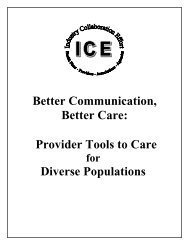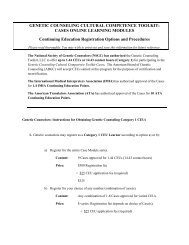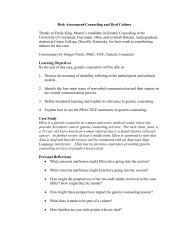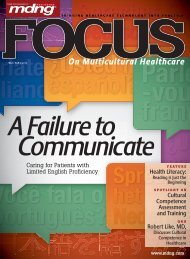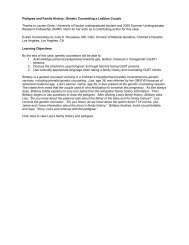Advanced Effective Communication, Cultural Competence, and ...
Advanced Effective Communication, Cultural Competence, and ...
Advanced Effective Communication, Cultural Competence, and ...
Create successful ePaper yourself
Turn your PDF publications into a flip-book with our unique Google optimized e-Paper software.
Glossary<br />
augmentative <strong>and</strong> alternative communication (AAC)<br />
resources Systems or devices that attempt to temporarily or<br />
permanently compensate <strong>and</strong> facilitate for the impairment<br />
<strong>and</strong> disability of individuals with severe expressive or language<br />
comprehension disorders. AAC may be required for<br />
individuals demonstrating impairments in gestural, spoken,<br />
<strong>and</strong>/or written modalities [1].<br />
auxiliary aids <strong>and</strong> services Devices or services that enable<br />
effective communication for people with disabilities.<br />
Examples include qualified interpreters, note takers,<br />
transcription services, written materials, assistive listening<br />
devices <strong>and</strong> systems, telephone communication devices for<br />
deaf persons, telephone h<strong>and</strong>set amplifiers, video interpretive<br />
services, <strong>and</strong> open <strong>and</strong> closed captioning [2].<br />
bilingual staff Individuals employed by the hospital who have<br />
some degree of proficiency in more than one language.<br />
Bilingual staff serve in a dual role for the hospital, providing<br />
interpreter services in addition to their primary position.<br />
care continuum A concept involving an integrated system of<br />
care that guides <strong>and</strong> tracks patients over time through a<br />
comprehensive array of health services spanning all levels of<br />
intensity of care [3].<br />
cultural competence The ability of health care providers <strong>and</strong><br />
health care organizations to underst<strong>and</strong> <strong>and</strong> respond effectively<br />
to the cultural <strong>and</strong> language needs brought by the patient to<br />
the health care encounter. <strong>Cultural</strong> competence requires<br />
organizations <strong>and</strong> their personnel to do the following: (1) value<br />
diversity; (2) assess themselves; (3) manage the dynamics of<br />
difference; (4) acquire <strong>and</strong> institutionalize cultural knowledge;<br />
<strong>and</strong> (5) adapt to diversity <strong>and</strong> the cultural contexts of<br />
individuals <strong>and</strong> communities served [4].<br />
culture Integrated patterns of human behavior that include<br />
the language, thoughts, communications, actions, customs,<br />
beliefs, values, <strong>and</strong> institutions of racial, ethnic, religious, or<br />
social groups [5].<br />
disparities Racial <strong>and</strong> ethnic differences in health care that are<br />
not attributable to other known factors [6].<br />
effective communication The successful joint establishment<br />
of meaning wherein patients <strong>and</strong> health care providers<br />
exchange information, enabling patients to participate actively<br />
in their care from admission through discharge, <strong>and</strong> ensuring<br />
that the responsibilities of both patients <strong>and</strong> providers are<br />
understood. To be truly effective, communication requires a<br />
two-way process (expressive <strong>and</strong> receptive) in which messages<br />
are negotiated until the information is correctly understood<br />
by both parties. Successful communication takes place only<br />
when providers underst<strong>and</strong> <strong>and</strong> integrate the information<br />
gleaned from patients, <strong>and</strong> when patients comprehend<br />
accurate, timely, complete, <strong>and</strong> unambiguous messages from<br />
providers in a way that enables them to participate<br />
responsibly in their care.<br />
family Two or more persons who are related in any way—<br />
biologically, legally, or emotionally. Patients <strong>and</strong> families<br />
define their families [7]. See also patient- <strong>and</strong> family-centered<br />
care<br />
gender expression The external characteristics <strong>and</strong> behaviors<br />
of individuals that are socially defined as either masculine or<br />
feminine, such as dress, grooming, mannerisms, speech<br />
patterns, <strong>and</strong> social interactions. Social or cultural norms can<br />
vary widely, <strong>and</strong> some characteristics that may be accepted as<br />
masculine, feminine, or neutral in one culture may not be<br />
assessed similarly in another [8]. See also gender identity <strong>and</strong><br />
sexual orientation<br />
gender identity A person’s innate, deeply felt psychological<br />
identification as male or female, which may or may not<br />
correspond to the person’s body or assigned sex at birth<br />
91



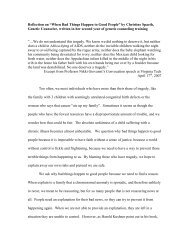
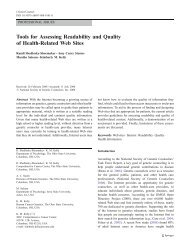

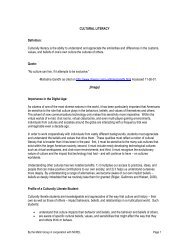
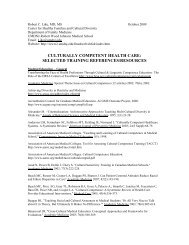

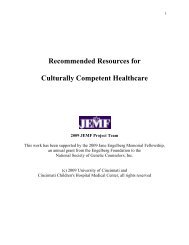

![Breaking Bad News PPT[1] - Genetic Counseling Cultural ...](https://img.yumpu.com/35003134/1/190x146/breaking-bad-news-ppt1-genetic-counseling-cultural-.jpg?quality=85)
